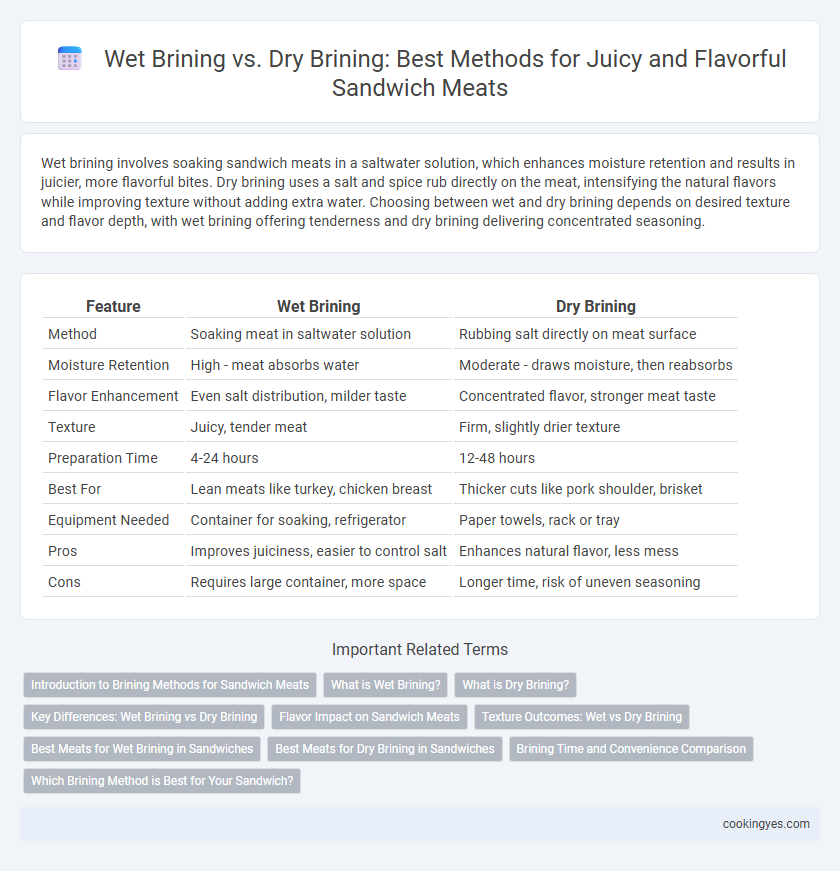Wet brining involves soaking sandwich meats in a saltwater solution, which enhances moisture retention and results in juicier, more flavorful bites. Dry brining uses a salt and spice rub directly on the meat, intensifying the natural flavors while improving texture without adding extra water. Choosing between wet and dry brining depends on desired texture and flavor depth, with wet brining offering tenderness and dry brining delivering concentrated seasoning.
Table of Comparison
| Feature | Wet Brining | Dry Brining |
|---|---|---|
| Method | Soaking meat in saltwater solution | Rubbing salt directly on meat surface |
| Moisture Retention | High - meat absorbs water | Moderate - draws moisture, then reabsorbs |
| Flavor Enhancement | Even salt distribution, milder taste | Concentrated flavor, stronger meat taste |
| Texture | Juicy, tender meat | Firm, slightly drier texture |
| Preparation Time | 4-24 hours | 12-48 hours |
| Best For | Lean meats like turkey, chicken breast | Thicker cuts like pork shoulder, brisket |
| Equipment Needed | Container for soaking, refrigerator | Paper towels, rack or tray |
| Pros | Improves juiciness, easier to control salt | Enhances natural flavor, less mess |
| Cons | Requires large container, more space | Longer time, risk of uneven seasoning |
Introduction to Brining Methods for Sandwich Meats
Wet brining involves soaking sandwich meats in a saltwater solution to enhance moisture retention and tenderness, while dry brining uses salt and seasonings directly on the meat to intensify flavor and improve texture. Both methods help in breaking down proteins and increasing juiciness, crucial for crafting flavorful and succulent sandwich fillings. Choosing between wet and dry brining depends on the desired flavor profile, texture, and processing time for the sandwich meats.
What is Wet Brining?
Wet brining involves soaking sandwich meats in a saltwater solution, which helps the meat retain moisture and enhances its flavor through osmotic pressure. This process typically includes water, salt, sugar, and various spices or herbs, allowing the meat to absorb these seasonings deeply. Wet brining is especially effective for lean meats like turkey or chicken, ensuring juiciness and tenderness in sandwich fillings.
What is Dry Brining?
Dry brining involves coating sandwich meats with a mixture of salt and spices, allowing the salt to penetrate and tenderize the meat while enhancing its natural flavors. Unlike wet brining, which uses a saltwater solution, dry brining draws moisture out, then reabsorbs it, resulting in juicier, more flavorful sandwich fillings. This technique also improves texture and helps retain moisture during cooking, making meats like turkey, chicken, or pork ideal for sandwiches.
Key Differences: Wet Brining vs Dry Brining
Wet brining involves submerging sandwich meats in a seasoned saltwater solution, which enhances moisture retention and results in juicier, tender slices. Dry brining uses a salt-based rub applied directly to the meat, drawing out moisture initially but then reabsorbing it to intensify flavor and improve texture without added water. Key differences include wet brining's longer preparation time and ability to impart subtle seasoning, whereas dry brining offers a more concentrated taste and firmer meat ideal for thicker sandwich cuts.
Flavor Impact on Sandwich Meats
Wet brining infuses sandwich meats with moisture and enhances tenderness by submerging them in a saltwater solution, which helps the meat retain juiciness during cooking. Dry brining uses a salt-based rub that draws out natural juices before reabsorbing them, intensifying the meat's flavor and creating a firmer texture ideal for sandwich slices. Both methods elevate the savory profile of sandwich meats, but dry brining offers a more concentrated taste boost without added moisture.
Texture Outcomes: Wet vs Dry Brining
Wet brining infuses sandwich meats with moisture, resulting in a juicy and tender texture that enhances bite satisfaction. Dry brining, by drawing out and then reabsorbing juices, intensifies natural flavors while producing a firmer, chewier texture ideal for robust sandwiches. Choosing between wet and dry brining depends on desired meat texture, with wet brining favoring softness and dry brining promoting a dense, concentrated mouthfeel.
Best Meats for Wet Brining in Sandwiches
Pork belly, turkey breast, and chicken thighs perform exceptionally well with wet brining for sandwiches due to their ability to retain moisture and enhance flavor depth. Wet brining infuses these meats with a balanced saltiness and juiciness, making sandwich fillings more tender and succulent. This method is especially effective for lean cuts that risk drying out during cooking, ensuring a moist and flavorful bite in every sandwich.
Best Meats for Dry Brining in Sandwiches
Dry brining enhances the flavor and texture of sandwich meats like turkey, chicken, and pork by drawing out moisture and allowing the salt to penetrate deeply. Best meats for dry brining in sandwiches are those with a firm texture and higher water content, such as turkey breast, pork loin, and chicken thighs, which benefit from improved juiciness and seasoning. This method prevents excess moisture, resulting in a perfectly balanced and tender sandwich filling.
Brining Time and Convenience Comparison
Wet brining sandwich meats typically requires several hours to overnight soaking in a saltwater solution, allowing deep moisture penetration and enhanced tenderness. Dry brining involves coating the meat with salt and spices, needing less time--often just 1 to 2 hours--offering a simpler, less messy process ideal for quick preparation. Choosing between wet and dry brining depends on available time and convenience, with dry brining providing faster results and easier cleanup for sandwich making.
Which Brining Method is Best for Your Sandwich?
Wet brining involves soaking sandwich meats in a saltwater solution, enhancing moisture retention and juiciness, ideal for lean cuts like turkey or chicken. Dry brining uses a salt and seasoning rub, drawing out moisture and intensifying flavor without added liquid, making it perfect for firmer meats like pork or beef. Choosing the best method depends on the meat type and desired texture, with wet brining promoting tenderness and dry brining delivering concentrated taste.
Wet brining vs dry brining for sandwich meats Infographic

 cookingyes.com
cookingyes.com